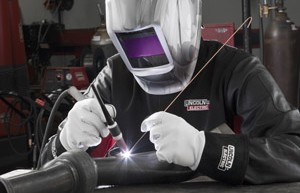This article will provide the necessary technical background to give you an appreciation for the complexity of the topic and then answers some of the most common questions filler metal suppliers receive. It establishes general guidelines for choosing appropriate stainless steel filler metals — and then explains all the exceptions to those guidelines.
Four Grades, Many Alloying Elements
Stainless steels have four principle categories: austenitic, martensitic, ferritic and duplex. The names are erived from the crystalline structure of the steel as it is usually found at room temperature. When low-carbon steel is heated above 1550°F, its atoms are rearranged from the structured called ferrite at room temperatures to the crystal structure called austenite. When cooling, the low-carbon steel atoms return to their original structure, ferrite. The high-temperature structure, austenite, is nonmagnetic and has lower strength and greater ductility than the room-temperature form of ferrite.
When more than 16 percent chromium is added to the steel, the room temperature crystalline structure, ferrite, is stabilized and the steel remains in the ferritic condition at all temperatures. Hence the name ferritic stainless steel is applied to this alloy base. When more than 17 percent chromium and 7 percent nickel are added to the steel, the high-temperature crystalline structure of the steel, austenite, is stabilized so that it persists at all temperatures from the very lowest to almost melting.
Austenitic stainless is commonly referred to as the “chrome-nickel” type, while martensitic and ferritic steels are commonly called the “straight chrome” types. Certain alloying elements utilized in stainless steels and weld metals act as austenite stabilizers and others as ferrite stabilizers. The most crucial austenite stabilizers are nickel, carbon, manganese and nitrogen. The ferrite stabilizers are chromium, silicon, molybdenum and niobium. The quantity of ferrite in the weld metal is controlled by the balancing of the alloying elements.
Austenitic grades are more readily and satisfactorily welded than those that contain less than 5 percent nickel. Weld joints produced in austenitic stainless steels are strong, ductile and tough in their as-welded condition. They do not usually require preheat or postweld head treatment. Austenitic grades account for approximately 80 percent of the stainless steel welded.
How Do I Choose the Correct Stainless Filler Metal?
If the base material in both plates is the same, the original guiding principle used to be, “Start by matching the base material.” This works well in some cases; to join Type 310 or 316, choose the corresponding filler type.
Follow this guideline principle to join dissimilar materials: choose a filler to match the more highly allowed material. Choose a 316 filler to join 304 to 316.
Unfortunately, the “match rule” has so many exceptions that a better principle is, “Consult a filler metal selection table.” For instance, Type 304 is the most common stainless steel base material, but no one offers a Type 304 electrode.
If I Am Supposed to Match the Filler Metal to the Base Metal, What Do I Use to Weld Type 304 Stainless?
Use Type 308 filler to weld Type 304 stainless. This is because the additional alloying elements in Type 308 will better stabilize the weld area.
However, 308L is also an acceptable filler. The “L” designation after any type indicates low carbon content. A Type 3XXL stainless has a carbon content content < 0.03 percent, where standard Type 3XX stainless can have a maximum carbon content of 0.08 percent.
Type L filler falls within the same classification as the non-L product, so fabricators can, and should strongly consider, using a Type L filler because lower carbon content reduces the risk of intergranular corrosion issues.
Fabricators using the gas metal arc welding (GMAW) process may also want to consider using a Type 3XXSi filler, as the addition of silicon improves wet out. In cases where the weld has a high or rough crown, or where the weld pool does not tie in well at the toes of a fillet weld or lap point, using an Si-type GMAW electrode can smooth the weld bead and promote better fusion.
If carbide precipitation is an issue, consider a Type 347 filler, which contains a small amount of niobium.
How Do You Weld Stainless Steel to Carbon Steel?
This situation occurs in applications where one portion of a structure requires a corrosion-resistant exterior face joined to a carbon steel structural element to lower cost. Consider Type 312 when joining a base material with no alloying elements desired.
As a cautionary note, austenitic stainless steels exhibit a rate of expansion that is about 50 percent greater than that of carbon steel. When joined, the different rates of expansion can cause cracking due to internal stresses unless the proper electrode and welding procedure are used.
What Are Proper Weld Preparation Cleaning Procedures?
Similar to any other metals, first start by removing oil, grease, markings and dirt with a nonchlorinated solvent. Once you’ve done this, the primary rule of stainless weld preparation is “avoid contamination from carbon steel to prevent corrosion.” Some companies use separate buildings for their “stainless shop” and “carbon shop” to prevent cross contamination.
Designate grinding wheels and stainless brushes as “stainless only” when preparing edges for welding. Some procedures cal for cleaning 2 inches back from the joint. Joint preparation is also more crucial, as compensating for inconsistencies with electrode manipulation is harder than with carbon steel.
What is the Proper Postweld Cleaning Procedure, or Why Does My Stainless Weld Rust?
To begin, remember what makes a stainless steel stainless: the reaction of chromium with oxygen to form a protective layer of chromium oxide on the surface of the material. Stainless rusts because of carbide precipitation and because the welding process heats the weld metal to the point where ferritic oxide can form on the surface of the weld. Left in the as-welded condition, a perfectly sound weld might show “wagon tracks” of rust at the boundaries of the heat-affected zone in less than 24 hours.
For a new layer of pure chromium oxide to properly form, stainless steel requires postweld cleaning by polishing, pickling, grinding or brushing. Again, use grinders and brushes dedicated to that task.
Why is My Stainless Steel Welding Wire Magnetic?
Fully austenitic stainless steel is nonmagnetic. However, welding temperatures create a relatively large grain in the microstructure, which results in the weld being crack sensitive. Electrode manufactures add alloying elements, including ferrite, to mitigate sensitivity to hot cracking. The ferrite phases causes the austenitic grains to be much finer, so the weld becomes more crack resistant.
While a magnet will not stick to a spool of austenitic stainless filler metal, a person holding a magnet might feel a slight pull because of the retained ferrite. Unfortunately, this causes some users to think their product has been mislabeled or they are using the wrong filler metal (especially if they tore the label off the wire basket).
The proper amount of ferrite in an electrode depends on the service temperature of the application. For instance, too much ferrite causes the weld to lose its toughness at low temperatures. Thus, Type 308 filler for an LNG piping application has a ferrite number between 3 and 6, compared to a ferrite number of 8 for standard Type 308 filler. Simply put, filler metals may seem similar at first, but small differences in composition are important.
Is There an Easy Way to Weld Duplex Stainless Steels?
Generally, duplex stainless steels have a microstructure consisting of approximately 50 percent ferrite and 50 percent austenite. Simply put, the ferrite provides high strength and some resistance to stress corrosion cracking while the austenite provides good toughness. The two phases in combination give the duplex steels their attractive properties. A wide range of duplex stainless steels is available, with the most common being Type 2205; it contains 22 percent chromium, 5 percent nickel, 3 percent molybdenum and 0.15 percent nitrogen.
When welding duplex stainless steel, problems could arise if the weld metal has too much ferrite (the heat from the arc causes the atoms to arrange themselves in a ferrite matrix). To compensate, filler metals need to promote the austenitic structure with higher alloy content, typically 2 to 4 percent more nickel than in the base metal. For instance, flux-cored wire for welding Type 2205 may have 8.85 percent nickel.
Desired ferrite content can range from 25 to 55 percent after welding (but can be higher). Keep in mind that the cooling rate must be slow enough to allow the austenite to reform, but not so slow as to create eintermetallic phases, nor to fast as to create excess ferrite in the heat-affected zone. Make sure to follow the manufacturer’s recommended procedures and guidelines for the weld process and filler metal selected.
Why Do I Keep Adjusting the Parameters When Welding Stainless Steel?
For fabricators who constantly adjust parameters (voltage, amperage, arc length, inductance, pulse width, etc.) when welding stainless steel, the typical culprit is inconsistent filler metal composition. Given the importance of alloying elements, lot-to-lot variations in chemical composition can have a noticeable impact on weld performance, such as poor wet out or difficult slag release. Variations in electrode diameter, surface cleanliness, cast and helix also affect performance in GMAW and FCAW applications.
How Do I Control Carbide Precipitation in Austenitic Stainless Steel?
At temperatures in the range of 800°-1600°F, carbon content in excess of 0.02 percent migrates to the grain boundaries of the austenitic structure, where it reacts with chromium to form chromium carbide. If the chromium is tied up with the carbon, it is not available for corrosion resistance. When exposed to a corrosive environment, intergranular corrosion results, which allows the grain boundaries to be eaten a way.
Keep the carbon content as low as possible by welding with low-carbon electrodes to control carbide precipitation. Carbon can also be tied up by niobium (formerly columbium) and titanium, which have a stronger affinity for carbon than does chromium. Type 347 electrodes are made for this purpose.
How Should I Prepare for a Discussion on Filler Metal Selection?
At a minimum, collect information on the end use of the welded part, including service environment (especially operating temperatures, exposure to corrosive elements, and degree of expected corrosion resistance) and desired service life. Information on required mechanical properties at operating conditions helps immensely, including strength, toughness, ductility and fatigue.
Most of the leading electrode manufacturers provide guidebooks for filler metal selection, and this cannot be overemphasized: consult a filler metal applications guide or contact their technical experts. They are there to assist you with selecting the correct stainless steel electrode.
Source: aws.org



Jose De Jesus Linares liked this on Facebook.
Tina Marie Adams liked this on Facebook.
Mike Roles liked this on Facebook.